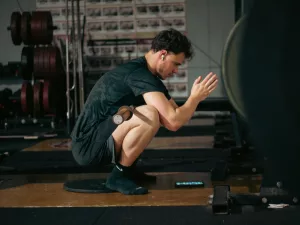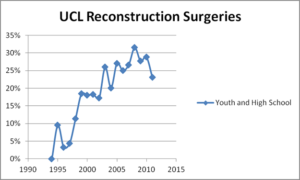These 5 Tips to Prevent Injury are a game changer!
We all want to increase pitching velocity but not in return for a career-ending injury. The problem is we are always walking the fine line between injury and injury prevention when it comes to enhancing performance and increasing pitching velocity. In this article, I will put together 5 critical tips to help you avoid injury while you enhance your pitching velocity with the 3X Pitching Velocity Program or not.
I definitely can't say we have not had any injuries with the 3X Pitching Velocity Program. Injury is a part of the game but what we haven't had is a career-ending injury. All of the injuries we deal with are some strains and sprains in the big muscle groups which heal usually in less than a week. The reason we have kept injury so low with the 3X Pitching Velocity Program is that we are as focused on injury prevention, as we are on taking your pitching velocity to 90+mph. I will now give you 5 critical tips for preventing injury while increasing pitching velocity which has been the secret to the success of the 3X Pitching Velocity Program.
The Factors of Most Pitching Injury
Before we dive into the 5 Tips to Prevent Injury you must learn what the cause of most pitching injuries is. The American Sports Medicine Institute (ASMI), in their youth pitching statement, credits most pitching injuries to 3 common factors. These factors are overuse, poor physical fitness, or poor mechanics. These factors are common also at any level of any sport. Let's look at what is causing these 3 factors of pitching injury in baseball to occur.
Overuse
What causes the overuse in baseball is too much playing time. Overuse is now out of control in the game of baseball especially at the youth level because of the money-driving travel ball today. When I was a kid it was common to go from one sport to another based on the season and if you only wanted to play one sport, then something was wrong with you. We also had a handful of multi-sport athletes in big league ball like Bo Jackson, Brian Jordan, and Deion Sanders.
Today it has flipped around. Now if you do not play baseball all year round then the conventional wisdom says you are going to be left behind. I call BS. This is just hype based on the money that is driving this mentality. Institutes like ASMI are performing an alarming amount of arm surgeries on youth ball players today (see graph above) and I believe it is positively correlated to this all-year travel ball mentality. This is why they advise youth ball players to take 2-3 months a year off from throwing in their youth pitching statement. They also advise the youth pitcher to participate in more physical fitness programs and to learn better pitching mechanics. Young pitchers today can not find the time to follow this advice because they are spending all of their days playing travel baseball; in summer, fall, winter, and spring.
Poor Physical Fitness
 The other factor in the pitching injury epidemic is the lack of strength and conditioning, especially for pitchers. The majority of the coaches in this game have not changed in the past 50 years when it comes to physically developing the pitcher. They still have the mentality that strength training for the pitcher will only reduce performance, injure the player and waste their time. This is exactly what football thought about strength training back in the 30s and 40s. If they would have stuck to this belief then, football would not be the game it is today.
The other factor in the pitching injury epidemic is the lack of strength and conditioning, especially for pitchers. The majority of the coaches in this game have not changed in the past 50 years when it comes to physically developing the pitcher. They still have the mentality that strength training for the pitcher will only reduce performance, injure the player and waste their time. This is exactly what football thought about strength training back in the 30s and 40s. If they would have stuck to this belief then, football would not be the game it is today.
There are countless studies, like the ones listed below (1,2), proving the critical importance of good physical fitness to baseball performance and injury prevention. These conventional coaches chose to live in ignorance of this cutting-edge information either because they were not coached with it or when they played the game strength and conditioning were not as developed for baseball as it is today. Instead of these coaches learning the new science of strength and conditioning today, they chose to scare the player from the topic together. The result is a ton of underdeveloped young baseball players who are more prone to injury when overuse occurs.
Poor Mechanics
 This is another factor of most injuries in baseball today that is caught up in the ignorance of conventional wisdom. The number of case studies that have been put out today and that have completely changed the understanding of the high-velocity pitcher continue to live in the shadows of the internet and medical libraries. Most parents and players would be shocked to see how much of this priceless information exists and how small of a percentage of coaches are using it. This is what I have built TopVelocity.net on and more coaches and players need to join this bandwagon.
This is another factor of most injuries in baseball today that is caught up in the ignorance of conventional wisdom. The number of case studies that have been put out today and that have completely changed the understanding of the high-velocity pitcher continue to live in the shadows of the internet and medical libraries. Most parents and players would be shocked to see how much of this priceless information exists and how small of a percentage of coaches are using it. This is what I have built TopVelocity.net on and more coaches and players need to join this bandwagon.
If you want to learn more of this cutting-edge information on the high-velocity pitcher then either read more of the articles on this site or check out the 3X Pitching Mechanics Guides Vol 1 and Vol 2.
Now for 5 critical tips for preventing injury while working hard to increase pitching velocity!
5 Tips to Prevent Injury While Increasing Pitching Velocity
- Do Not Ever Overthrow - This is the overuse factor of most pitching injuries. You are asking for it if you constantly push your limits here. You do not need to overthrow to strengthen your arm. Most conventional coaches want you to believe this but all of the studies show overthrowing is detrimental to the arm (3,4). Throwing is mainly for mechanics training and endurance training to build up for the season but overthrowing would be negative for both mechanics training and endurance training. The 3X Pitching Velocity Program uses a light Med Ball Throwing program to train mechanics without overusing the shoulder and elbow joints.
- Fix Your Breaking Balls - When my pitching velocity broke 90mph my curveball really took a toll on my arm. The problem was my curveball grip and mechanics was horrible. I would try to break the ball off halfway through my arm path. This put tremendous torque on my elbow and shoulder which was made even worse when I started increasing my arm speed. This is why most high-velocity pitchers teach pitch grips and not wrist movements when coaching breaking balls. If you have a lot of wrist movement with your breaking balls and you start increasing arm speed, the injury will occur. The key is to learn breaking balls with little to no wrist movement as you increase pitching velocity.
- Improve Hip Mobility - Hip mobility is so important to performance but at the same time, it is critical to injury prevention. When the hips are restricted in movement then the body must overcompensate for this lack of rotation with poor mechanics from the ground up. In most cases, you will not improve pitching mechanics with poor hip mobility. At the 3X Velocity Camps, we are very focused on improving hip mobility from the very beginning.
- Never Sacrifice Technique for Weight in the Gym - This should be obvious. Once our lifting technique gets worse the body is put in positions where injury can occur. Especially when performing more complex movements like the Olympic Lifts. Do not let your technique go when attempting a personal record with weight or if you are just overtired. This usually doesn't lead to serious injury. It usually causes the typical sprains and strains but continuously falling into these injuries will slow down progress and frustrate the athlete.
- Take a Week off From Everything if You Are Constantly Sore - Overtraining is overuse. To prevent this, if your body is so tired it is starting to break down at a rapid pace and you can not keep your recovery up with it then you need to stop everything and take a week off. Your body will actually hypertrophy or remodel more fast-twitch muscle fibers in that rest week than it did during your entire training cycle.
- Bonus: Rest, Rest, Rest - I can never stress this enough. When we sleep our body produces more hormones to help speed recovery. If you are cutting this off then your body will begin to spiral down into injury. Never sacrifice sleep for anything when training hard to enhance performance.
5 Tips to Prevent Injury Reference:
- Kohmura Y, Aoki K, Yoshigi H, Sakuraba K, Yanagiya T. - Development of a baseball-specific battery of tests and a testing protocol for college baseball players. - Doctoral Program in Health and Sports Science, Juntendo University, Chiba, Japan. - J Strength Cond Res. 2008 Jul;22(4):1051-8.
- Fleck SJ, Falkel JE. - Value of resistance training for the reduction of sports injuries. - Sports Med. 1986 Jan-Feb;3(1):61-8.
-
Fleisig G, Andrews J, Cutter G, Weber A, Loftice J, McMichael C, Hassel N, Lyman S. - Risk of Serious Injury for Young Baseball Pitchers: A 10-Year Prospective Study. - Am. J. Sports Med. 2010;20(10): 1-5.
-
Lyman S, Fleisig GS, Andrews JR, Osinski ED. - Effect of pitch type, pitch count, and pitching mechanics on risk of elbow and shoulder pain in youth baseball pitchers. - Am J Sports Med. 2002; 30(4):463-468.




